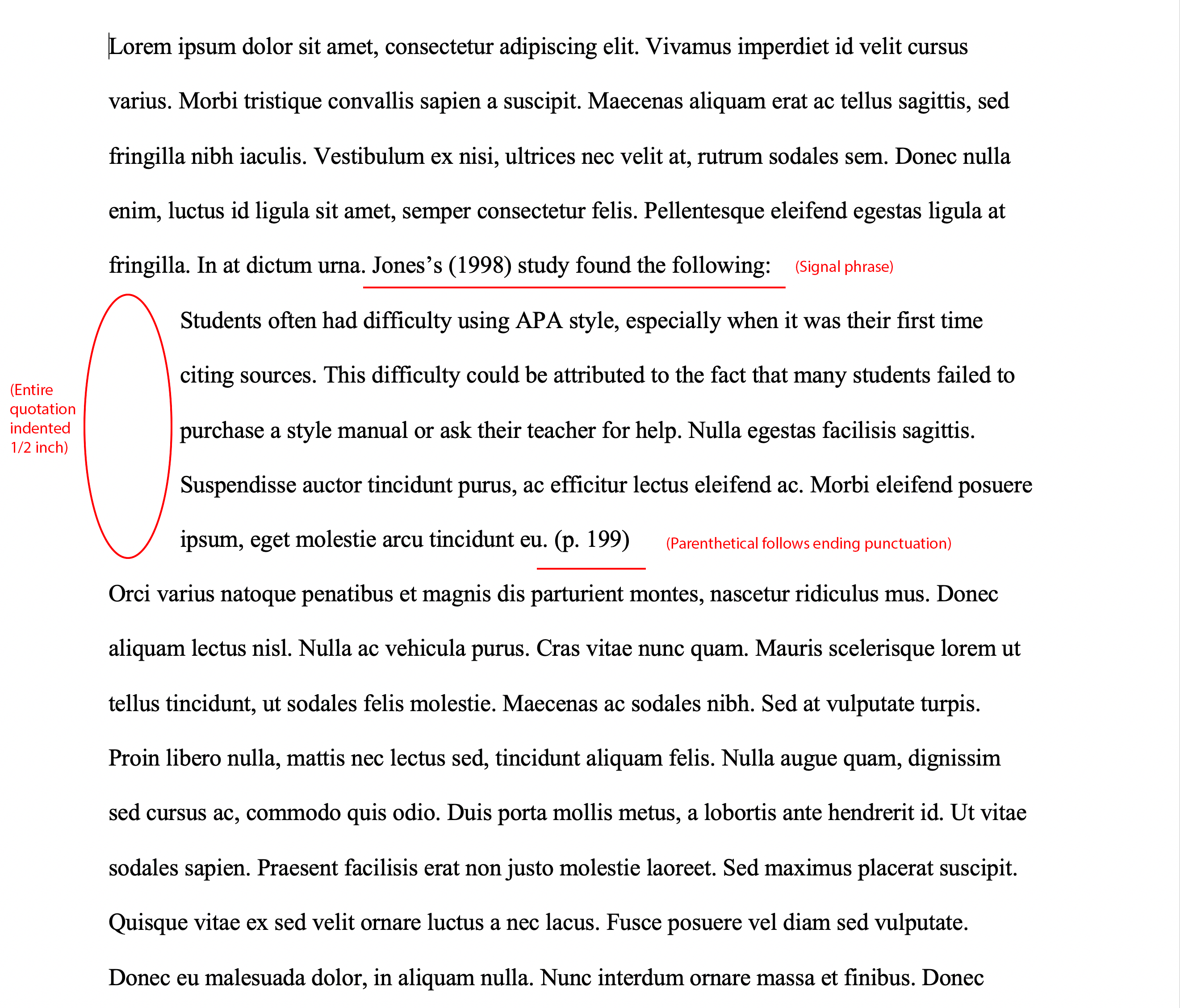In-Text Citations: The Basics

Welcome to the Purdue OWL
This page is brought to you by the OWL at Purdue University. When printing this page, you must include the entire legal notice.
Copyright ©1995-2018 by The Writing Lab & The OWL at Purdue and Purdue University. All rights reserved. This material may not be published, reproduced, broadcast, rewritten, or redistributed without permission. Use of this site constitutes acceptance of our terms and conditions of fair use.
Note: This page reflects the latest version of the APA Publication Manual (i.e., APA 7), which released in October 2019. The equivalent resource for the older APA 6 style can be found here.
Reference citations in text are covered on pages 261-268 of the Publication Manual. What follows are some general guidelines for referring to the works of others in your essay.
Note: On pages 117-118, the Publication Manual suggests that authors of research papers should use the past tense or present perfect tense for signal phrases that occur in the literature review and procedure descriptions (for example, Jones (1998) found or Jones (1998) has found...). Contexts other than traditionally-structured research writing may permit the simple present tense (for example, Jones (1998) finds).
APA Citation Basics
When using APA format, follow the author-date method of in-text citation. This means that the author's last name and the year of publication for the source should appear in the text, like, for example, (Jones, 1998). One complete reference for each source should appear in the reference list at the end of the paper.
If you are referring to an idea from another work but NOT directly quoting the material, or making reference to an entire book, article or other work, you only have to make reference to the author and year of publication and not the page number in your in-text reference.
On the other hand, if you are directly quoting or borrowing from another work, you should include the page number at the end of the parenthetical citation. Use the abbreviation “p.” (for one page) or “pp.” (for multiple pages) before listing the page number(s). Use an en dash for page ranges. For example, you might write (Jones, 1998, p. 199) or (Jones, 1998, pp. 199–201). This information is reiterated below.
Regardless of how they are referenced, all sources that are cited in the text must appear in the reference list at the end of the paper.
In-text citation capitalization, quotes, and italics/underlining
- Always capitalize proper nouns, including author names and initials: D. Jones.
- If you refer to the title of a source within your paper, capitalize all words that are four letters long or greater within the title of a source: Permanence and Change. Exceptions apply to short words that are verbs, nouns, pronouns, adjectives, and adverbs: Writing New Media, There Is Nothing Left to Lose.
(Note: in your References list, only the first word of a title will be capitalized: Writing new media.)
- When capitalizing titles, capitalize both words in a hyphenated compound word: Natural-Born Cyborgs.
- Capitalize the first word after a dash or colon: "Defining Film Rhetoric: The Case of Hitchcock's Vertigo."
- If the title of the work is italicized in your reference list, italicize it and use title case capitalization in the text: The Closing of the American Mind; The Wizard of Oz; Friends.
- If the title of the work is not italicized in your reference list, use double quotation marks and title case capitalization (even though the reference list uses sentence case): "Multimedia Narration: Constructing Possible Worlds;" "The One Where Chandler Can't Cry."
Short quotations
If you are directly quoting from a work, you will need to include the author, year of publication, and page number for the reference (preceded by "p." for a single page and “pp.” for a span of multiple pages, with the page numbers separated by an en dash).
You can introduce the quotation with a signal phrase that includes the author's last name followed by the date of publication in parentheses.
If you do not include the author’s name in the text of the sentence, place the author's last name, the year of publication, and the page number in parentheses after the quotation.
Long quotations
Place direct quotations that are 40 words or longer in a free-standing block of typewritten lines and omit quotation marks. Start the quotation on a new line, indented 1/2 inch from the left margin, i.e., in the same place you would begin a new paragraph. Type the entire quotation on the new margin, and indent the first line of any subsequent paragraph within the quotation 1/2 inch from the new margin. Maintain double-spacing throughout, but do not add an extra blank line before or after it. The parenthetical citation should come after the closing punctuation mark.
Because block quotation formatting is difficult for us to replicate in the OWL's content management system, we have simply provided a screenshot of a generic example below.

Formatting example for block quotations in APA 7 style.
Quotations from sources without pages
Direct quotations from sources that do not contain pages should not reference a page number. Instead, you may reference another logical identifying element: a paragraph, a chapter number, a section number, a table number, or something else. Older works (like religious texts) can also incorporate special location identifiers like verse numbers. In short: pick a substitute for page numbers that makes sense for your source.
Summary or paraphrase
If you are paraphrasing an idea from another work, you only have to make reference to the author and year of publication in your in-text reference and may omit the page numbers. APA guidelines, however, do encourage including a page range for a summary or paraphrase when it will help the reader find the information in a longer work.